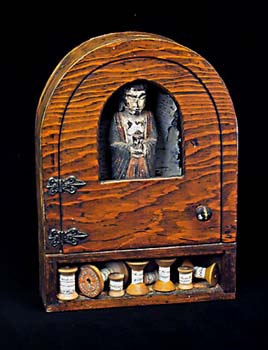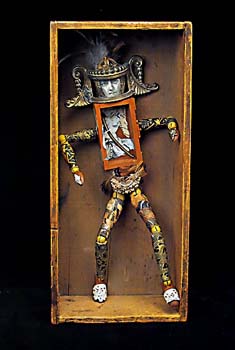Santa
Barbara News-Press
Art
and Wisdom
ANNE LUTHER'S WORK CROSSES ASSEMBLAGE ART MESSENGERS Information: 965-0142 By Charles Donelan NEWS-PRESS CORRESPONDENT Surrealism and self-help are not, on the face of it, compatible. Yet each of the 25 graceful assemblage artworks that make up Anne Luther's new exhibit at the Faulkner West Gallery has a title that could be advice from a friend.
The "messengers" of the exhibition title are those who have, through their wisdom and generosity of spirit, helped the artist to realize her vision and live her life. These meticulously crafted works, with their gorgeous inventory of enigmatic objects, testify that their creator is also a prodigious collector and cultivator of aesthetic relationships. In No. 20, "You can fly," the downward gaze of the central feminine mask toward the dreamlike nest of white feathers in the drawer below seems to regard the feathers as a symbol of potential flight, while the butterfly on its brow suggests that, at least in our minds, we often already do take flight. "You can fly" effortlessly realizes that most difficult of surrealist projects, the successful actualization of a dream As with dreams, the secret power of these works lies in their tendency to foster multiple interpretations. Several of the pieces refer to the Zen tradition. One, No. 26, "When the student is ready the teacher appears," is of special relevance to the whole project of this particular show. The arched cabinet with its closing, windowed door is more elaborate and imposing than some of the other, plainer boxes that surround it, but the meditating Buddha figure within lends a note of spiritual simplicity for balance. The small shelf below holds eight spools, each stripped of thread and rewrapped with cryptic messages. It is as though the implied spinning of these magic objects were the "open sesame" that would beckon for the god above to open his door. Students of art and seekers of wisdom must be ready, because in "Messengers," Anne Luther has made her appearance.
|


 No. 16, "Stay with your purpose," could be ironic, with its
central figure of a marionette suggesting the difficulty of knowing
who or what is pulling one's strings. Yet the jaunty, almost dancing
pose, the elaborate surface decoration of the limbs, and the substitution
of a frame for the generic torso and of an ornate crown and picture
composition for the generic head suggest that this marionette has attained
some independence, at least from the compliance of anonymity. Perhaps
this is not a marionette at all, but rather an artist's figure model,
customized and infused with an artist's vitality, ready to step right
out of the box.
No. 16, "Stay with your purpose," could be ironic, with its
central figure of a marionette suggesting the difficulty of knowing
who or what is pulling one's strings. Yet the jaunty, almost dancing
pose, the elaborate surface decoration of the limbs, and the substitution
of a frame for the generic torso and of an ornate crown and picture
composition for the generic head suggest that this marionette has attained
some independence, at least from the compliance of anonymity. Perhaps
this is not a marionette at all, but rather an artist's figure model,
customized and infused with an artist's vitality, ready to step right
out of the box.